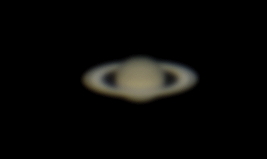
Critters; ISS Observing; D7000 Saturn, Moon
Posted: 27 April 2013
The observatory was opened Friday, 26 April, at 1820 MST, 91°F. The sky was clear and there was no wind. On my way to the observatory I took this photo of the "baby" birds in their nest. They have now grown up and are learning to fly.

While I was opening the observatory, one of their parents kept a watchful eye on me:

Something else also kept an eye on me:

The birds are Say's phoebe and a red-tailed hawk.
At 1855 MST, viewed Venus, low in the west and in a tree, 83X. Its disk was basically full. I tried 222X but it was too low in the sky for good viewing. I slewed to Sirius and did some tweaking of the finderscope alignment. Finished that at 1903 MST. Sunset was at 1905 MST. At 1915 MST, viewed the double star Castor, 83X and 222X. It was a nice view against the still bright blue sky.
Slewed to Jupiter at 1920 MST. Using 222X, three moons were visible off to the side of the planet, as was a moon shadow in transit. The shadow in transit was from Io, which was not visible (seeing was not very good). At 1940 MST, Io became visible just after ending its transit; the shadow was still in transit. At 1946 MST, seeing was very bad. Switched back to 83X, but Io's shadow was not visible due to the bad seeing.
Slewed to M42 in Orion. GOTO was a little off, so did a SYNC on Procyon. Then back to M42. Some nebulosity was visible 30 minutes before the end of astronomical twilight. At 2010 MST, slewed to the position of Comet C/2012 S1 (ISON) to check where it was in the sky. Although still too faint to be seen visually (about Mag +15), I plan to image it on the next session. This night, the rising waning gibbous moon would brighten the sky just as astronomical twilight was ending.
2020 MST, Zodiacal Light was visible.
At 2027 MST, began a tour of some DSOs in the constellation of Hydra using the 2" 24mm Ultra-Wide Angle eyepiece (83X). Viewed the Ghost of Jupiter (planetary nebula), M68 (globular cluster), and M48 (open cluster). I tried viewing some other DSOs but they were too low in the sky.
I then decided to observe the upcoming ISS pass through the telescope. The pass would be too low in the sky for good imaging, but since I had not viewed the ISS through the telescope in several years, this would be a good opportunity to do that. I did not update the ISS TLE; I used the previous day's TLE which I had entered for that night's ISS imaging. The pass was from 2058 MST to 2102 MST. I viewed it at 83X. Tracking was pretty good, usually requiring just minimal corrections to keep the ISS in the eyepiece. The station core and solar panels were clearly visible. It was fun to view the ISS through the telescope once again.
Since the object GOTOs were a little off this night, I next did a fresh One Star AutoStar alignment.
At 2114 MST, viewed Saturn, 83X. Four moons were visible. It was currently too low in the southeast for imaging. The moon was about to rise over the hill. At 2122 MST, switched to the 2" 9mm 100° eyepiece (222X). Seeing was a little better now. I prepped the D7000 DSLR for prime focus imaging. The moon appeared at 2134 MST. I resumed Saturn observing, 222X. The A, B, and C rings were all visible, as was Cassini Division and several cloud bands. I tried to see the Encke Gap but did not detect it. Switched to a 1.25" 5.5mm eyepiece (364X), but seeing was not good enough for that much magnification.
Began setting up for Saturn imaging. Mounted the D7000 DSLR at prime focus of the 8" LX200-ACF. At 2141 MST, did a focus test using the star Spica with the Bahtinov Mask. I then did a series of 45 second HD videos at 1/60sec with various ISO settings. The image scale was too small to be useful. I added the 3X TeleXtender and did another focus test image. I then repeated the series of 45 second HD videos, 1/60sec, at various ISO settings. This is a stack of 973 frames, 1/60sec, ISO 6400:

I plan to repeat the imaging experiment on the next session. Hopefully seeing will be better.
I then slewed to the moon, still in the tree to the southeast. Removed the TeleXtender and added the focal reducer. Using the 2" visual back (with 1.25" adapter), captured this (slightly cropped) image of the moon, 1/320sec, ISO 100, at 2228 MST:

Removed the camera and focal reducer and did some lunar observing, 222X. Then viewed Saturn, 222X. Seeing was still not very good.
Closed the observatory at 2249 MST, 63°F.
Comments are welcome; use the Comments section below, or you can Email Me. Thanks.
Cassiopeia Observatory Home Page